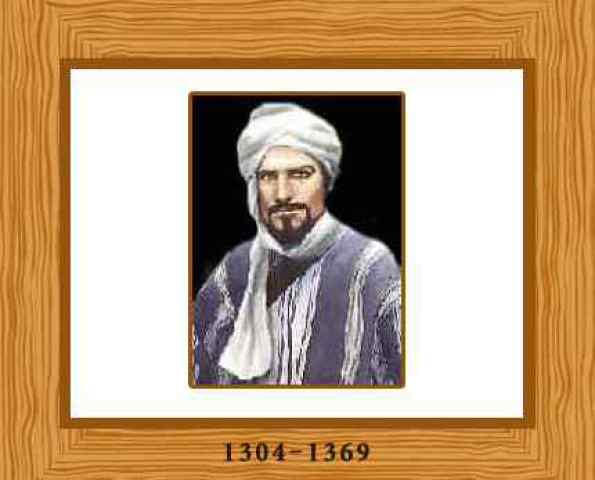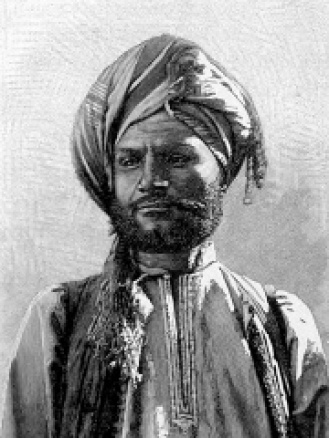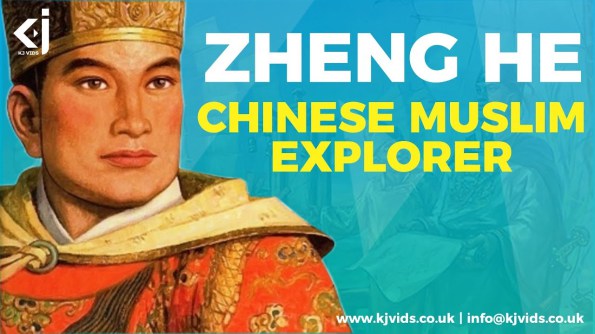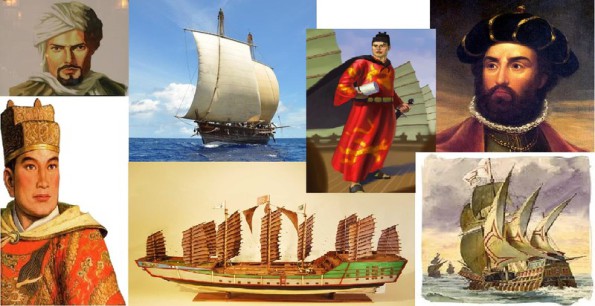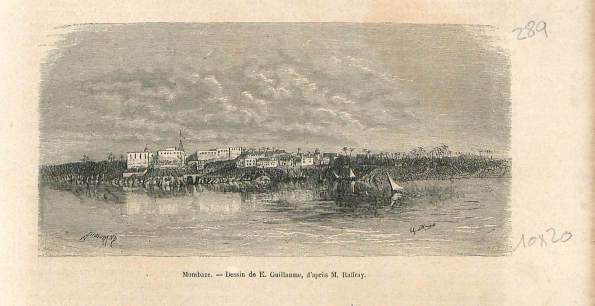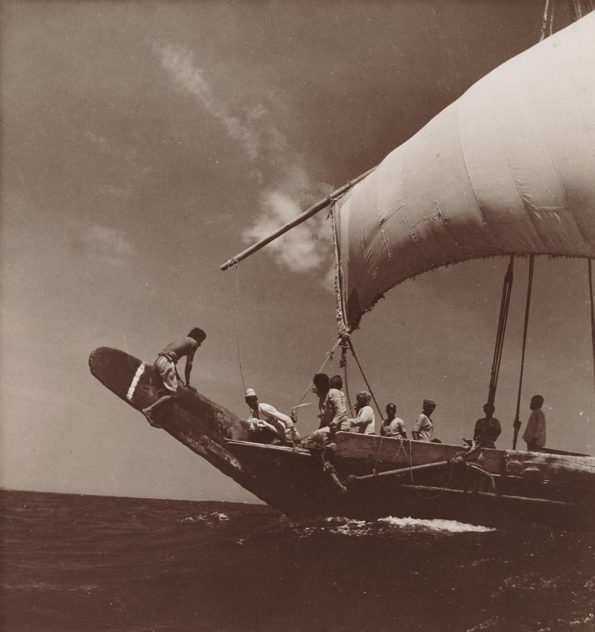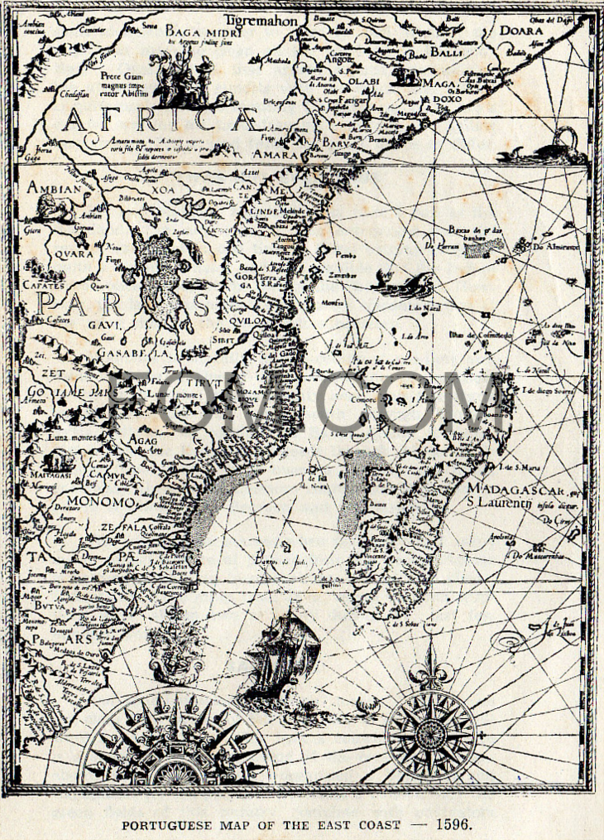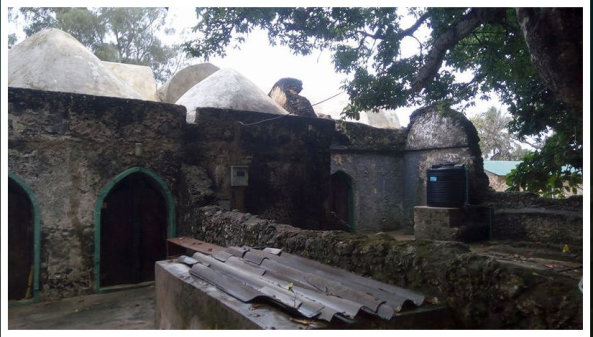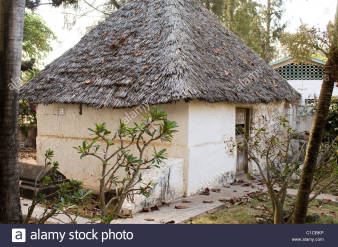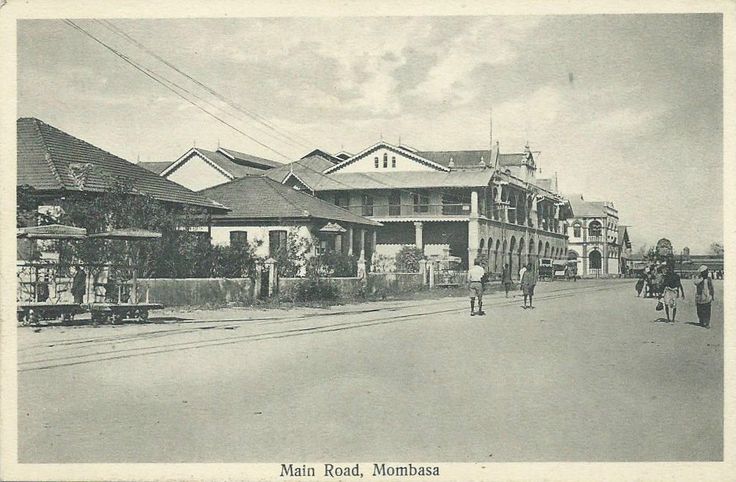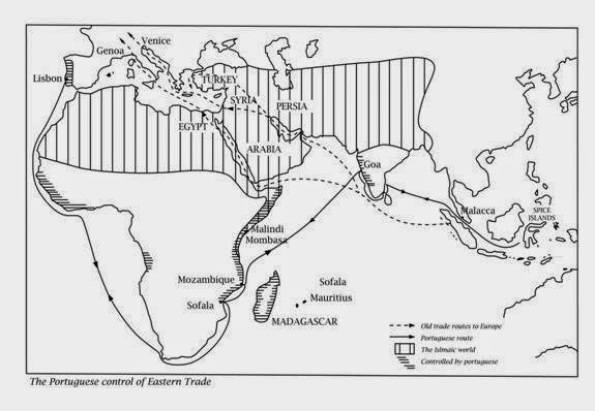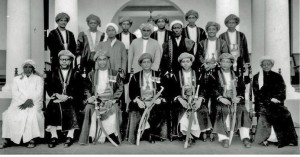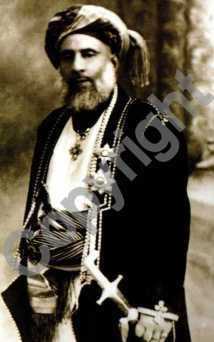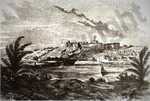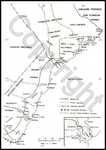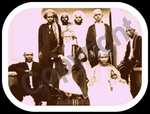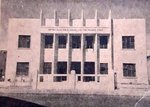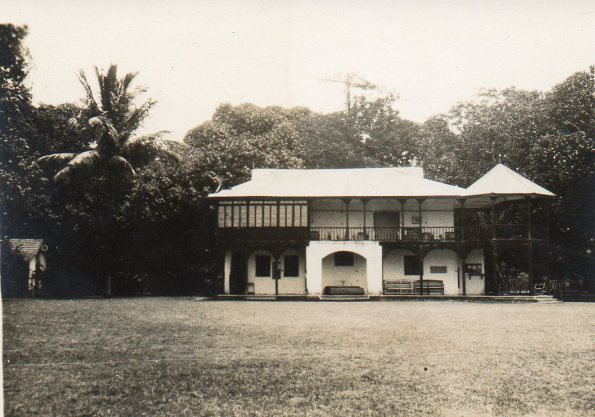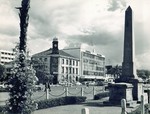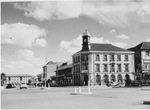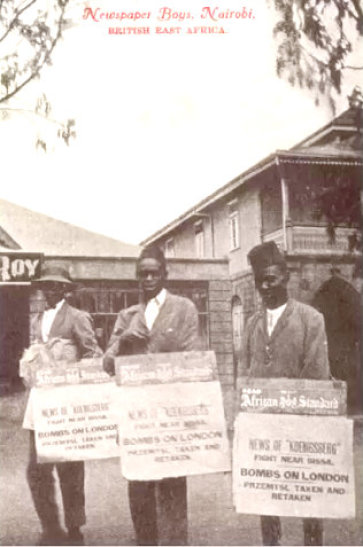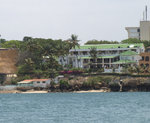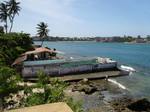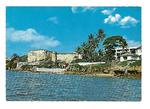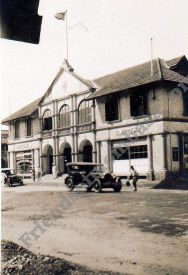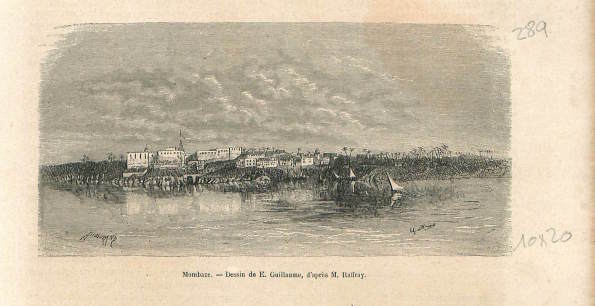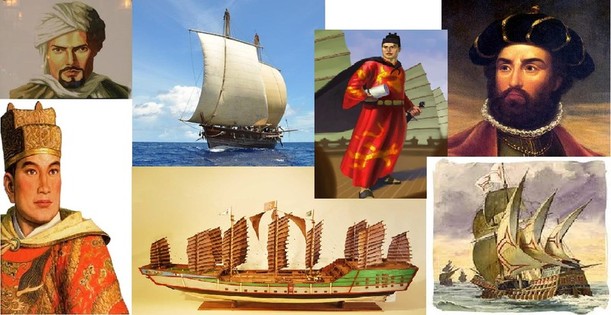Why Arab Scholar Ibn Battuta is the Greatest Explorer of all Time
In the 14th century, the Moroccan wanderer Ibn Battuta spent nearly 30 years traveling some 75,000 miles across Africa, the Middle East, India and Southeast Asia.
Why Moroccan Scholar Ibn Battuta is the Greatest Explorer of all Time
In the 14th century, the Moroccan wanderer Ibn Battuta spent nearly 30 years traveling some 75,000 miles across Africa, the Middle East, India and Southeast Asia.
https://www.history.com/news/why-arab-scholar-ibn-battuta-is-the-greatest-explorer-of-all-time?fbclid=IwAR3syYWaBIsdASvp8WzRYehl6iZTLeKphvB3JT1om6JORJ7sqfGCivA6_F8
Historians and scholars gathered at Gujarat's port town Mandvi are discussing how a
Kutchi sailor, Kanji Malam (the word malam stands for a navigator, one might find oneself completely ‘at sea’, so to speak)
Click below.....
http://www.friendsofmombasa.com/migration-rich-cultures/communities-of-mombasa-east-africa/the-kutchi-people/
Ahmad Ibn Majid
Aḥmad ibn Mājid ( أحمد بن ماجد), known as "AmirAl Bahr Alarabi" in Arabic (أمير البحر العربي) which means "the prince of the sea" and known also as the Lion of the Sea, was an Arab navigator and cartographer born c. 1432 in Julfar, part of Oman under the Nabhani dynasty rule at the time, (present-day Ras Al Khaimah, United Arab Emirates). He was raised in a family famous for seafaring; at the age of 17 he was able to navigate ships. The exact date is not known, but ibn Majid probably died in 1500.
https://pantheon.world/profile/person/Ahmad_ibn_M%C4%81jid/
Ahmad Ibn Majid, the great Muslim Navigator, is also famous in the West because it is said he helped guide the Portuguese Navigator, Vasco da Gama on his historic voyage to India — which was a first by a European by way of the Cape of Good Hope and the Indian Ocean. It is also alleged that da Gama, who had reached Malindi, in East Africa, had been looking for a guide/helper to take him to India — a route that was until then unknown to European navigators
https://www.lemauricien.com/le-mauricien/ahmad-ibn-majid-master-mariner-ther-indian-ocean/175368/
ZHENG HE - The Greatest CHINESE MUSLIM Explorer
https://www.kjvids.co.uk/meet-zheng-he-the-greatest-chinese-muslim-explorer/
Biography of Explorer Cheng Ho
The Famous Chinese Eunuch Admiral-Explorer of the 15th Century
The Project Gutenberg EBook of A Journal of the First Voyage of Vasco da
Gama 1497-1499, by Unknown
This eBook is for the use of anyone anywhere at no cost and with
almost no restrictions whatsoever. You may copy it, give it away or
re-use it under the terms of the Project Gutenberg License included
with this eBook or online at www.gutenberg.org
Unyama wa Vasco da Gama na Kanisa Katholiki dhidi ya Waswahili.
Brief History of Mombasa
Mombasa is the second largest city in Kenya. Located on Kenya's Eastern coastline bordering the Indian Ocean, it’s original Arabic name is Manbasa. In Kiswahili, it is called "Kisiwa Cha Mvita", which means "Island of War" due to the many changes in its ownership.
The history of the city is a mixture of African, Persian, Arab, Portuguese and British influences which contributed to the rich cultures found in the city today. Mombasa, a great trading centre with several items such as glass, brass, copper, iron and rhino horn passing through the coast, was originally inhabited by the African Bantu people. The city was then visited by Jordanians in 6th century, Persians in the 9th and 10th century and thereafter Arabs. In this period the Arabs and Persians developed trading routes, commercial centers and contributed to a flowering of civilization reflected in the glorious architecture of their grand houses, monuments and mosques.
https://www.mombasa-city.com/brief_history_of_Mombasa.htm
A Brief History of Mombasa - Lets Move
--------------------------------------------------------------------
According to Krapf, name is given by Arabs, the old story that is believed, that the first Arab who came, his name was Shehe Mvita. According to Ptolemy the name was Tonike. Some people say “Mvita ” means the Island of war or “Mfita” the place of hiding dubbed by the warriors of Pate.
In fact the coastal name “Bombaza” was actually in the Spanish manuscript and translated, mentioned by Duarate Barbosa in the very early
16th Century.
How “Malindi” got its name is not clear either, some say it derives from “Malinda” and its source was when the Bantu people of Africa migrated that we now call Uganda to the coast.
Swahili language, also called kiSwahili, or Kiswahili, Bantu language spoken
either as a mother tongue or as a fluent second language on the east coast of Africa in an area extending from Lamu Island, Kenya, in the north to the southern border of Tanzania in the south. (The Bantu languages form a subgroup of the
Benue-Congo branch of the Niger-Congo language family.)
People who speak Swahili as their sole mother tongue are usually referred to as Waswahili, but this name refers to their language only and does not denote any particular ethnic or tribal unit.
Swahili is widely used as a lingua franca in: (1) Tanzania, where it is the language of administration and primary education;
(2) Kenya, where it is, after English, the main language for these purposes; (3) Congo (Kinshasa), where a form of Swahili is one of the four languages of administration, the main language for this
purpose being French; and (4) Uganda, where the main language is again English. Swahili has been greatly influenced by Arabic; there are an enormous number of Arabic loanwords in the language, including the word swahili, from
Arabic sawāḥilī (a plural adjectival form of an Arabic word meaning “of the coast”).
The language dates from the contacts of Arabian traders with the inhabitants of the east coast of Africa over many centuries. Under Arab influence, Swahili originated as a lingua franca used by
several closely related Bantu-speaking tribal groups. In the early 19th century, the spread of Swahili inland received a great impetus from its being the language of the Arab ivory and slave caravans, which penetrated as far north as Uganda and as far west as
Congo.
Swahili was later adopted by European colonialists, especially the Germans, who used it extensively as the language of administration in Tanganyika, thus laying the foundation for its adoption as a national language of independent Tanzania.
In Kenya and Uganda, other local languages also received official encouragement during the colonial period, but the tendency in these countries is now to emphasize the use of Swahili. The oldest
preserved Swahili literature, which dates from the early 18th century, is written in the Arabic script, though the language is now
written in the Roman alphabet.
Nine Tribes and the other Three
The tribes were supposed to have originated from the locality of Mjiwakali, which is the part of Mombasa where the dhobie ghat stands, between the Club and
Nyali bridge. The tribes are thought to be Mombasa (or Mvita, or Mfita), Mtwapa (or Mtwafi), Kilifi, Pate, Shaka, Faza, Akatwa (or Somali), Gunya (or Bajun) and Junda (or
Jomvu).
These tribes exercised suzerainty over the localities along the coast as suggested by their names, and they have always been regarded as Swahili—a race of
pure bred Arabs from the Arabian peninsula intermixed with the black tribes found in East Africa.
Actually there were twelve tribes in Mombasa. The three remaining were the Kilindini, Watangana and the VVachangamwe. These three were bitter enemies of the nine tribes and their headquarters were at Mbaraki.
IllAMA TRIBES
All over Africa tribes still retain their llama names. Some have changed almost, out of recognition. But there are two tribes on this coast that have not
changed. The Wajomvu and the Wadigo (Wadege). This latter chose the name ‘People of the Birds'. And within living memory the old women of the Wadigo tribe would not eat the flesh of a bird.
It was their tribal llama.
So here we have two of the llama tribes. And people who know of these things say that when they listen at nights on the coast, the sound of the drums, the
death and pepo dances, are almost identical to those they have heard in Uganda. And they also say that wherever the Bantu people went they took with them the old place names they were used to.
The following are names from Uganda. Think of the coast names they resemble. Masindi, Kisindi, Bumbire, Ribo, Petta, Kilim and Bulinda. There are dozens of others . . . but Malindi might easily have
been one of them years ago, don’t you think?
More on MALINDI
Malte Brun, Who was he? He wrote a geography of this Coast. No idea when it was published.
But I know that it was considered famous nearly one hundred and fifty years ago. The only remark Malte made about our bit of the coast was ‘What has become of
the famous city of Melinda, and the twenty churches of Mombasa?—do they exist?’ That’s cryptic enough, if you like. The famous city of Malinda. Up it pops again. I heard an unusual thing the other
day. Of how Malindi got its name. From a source you’d never guess. From Uganda. This is the story. It comes from an old witchdoctor, queerly enough.
As you know the Bantu peoples of Africa originally came from the country we now call Uganda and thereabouts. Because of sickness or drought, soil erosion or other causes they began to trek. Some tribes eventually reached the Cape, others came down to this coast. One story says that these tribes were the llama tribes. Before their departure from their old haunts they agreed to each tribe taking the name of an animal. They would become blood brothers to the animal they had chosen. They were not to kill their blood brethren, but other tribes could. The result would mean equal distribution of food. Edward Rodwell
The Mijikenda (“the Nine Tribes”) are nine Bantu ethnic groups inhabiting the coast of Kenya, between the Sabaki and the Umba rivers, in an area stretching from the border with Tanzania in the south to the border near Somalia in the north.
SWAHILIS
The name Swahili is an Exonym derived
from Arabic: سواحل, romanized: Sawāhil, lit. 'coasts'. Swahili people speak the Swahili language. Swahili people's endonym for themselves is Waungwana, which means "the civilized ones." Modern
Standard Swahili, derived from the Kiunguja dialect of Zanzibar.
Like many other world language, Swahili has borrowed a number of words from foreign languages, particularly administrative terms from Arabic, but also words from Portuguese, Hindi and German. Other,
older dialects like Kimrima and Kitumbatu have far fewer Arabic loanwords, indicative of the language's fundamental Bantu nature.
Kiswahili served as coastal East Africa's lingua franca and trade language from the ninth century onward. Zanzibari traders' intensive push into the African interior from the late eighteenth century
induced the adoption of Swahili as a common language throughout much of East Africa.
hus, Kiswahili is the most spoken African language though it is used by far more than just the Waswahili themselves.
Today the Mombasa Swahilis are namely
*Wa jomvu
*Wa changamwe
*Wa Pate
*Wa Kilindini
*Wa Ngunya
*Wa Tangana
These are the remaining original Swahilis of Mombasa from 11th century before Shugwaya brought about the Taifas and the mijikenda
Jonah Kieti
Lesser-Known Heroes of The Pre-colonial Coast of Kenya
by Samia Bwana
|
Brief History of Mombasa |
|
Mombasa is the second largest city in Kenya. Located on Kenya's Eastern coastline bordering the Indian Ocean, it’s original Arabic name is Manbasa. In Kiswahili, it is called "Kisiwa Cha Mvita", which means "Island of War" due to the many changes in its ownership. |
MONSOON DHOWS
Sailors have harnessed the Indian Ocean’s monsoon winds for at least two millennia. The Swahili term “dhow” encompasses a diversity of sailing ships, from coastal fishing boats to
ocean-going vessels. Dhows drew the cosmopolitan urban communities of Indian Ocean world together. The seasonal patterns of monsoons meant that sailors would stay in distant ports for months at a
time. They took sojourns in the cities of east Africa and the Horn, the Arabian Peninsula, Persia, India, and beyond to China, Sumatra and Java. Dhow routes created intricate loops of cultural
exchange – gold and cotton, migrants and merchants, and marriages that tied together people from distant lands. Indian Ocean cities and their citizens continue to reflect the long duration of this
cultural dynamism.
Afrasian Memories in East Africa
History, The Portuguese Empire (1498-1698)
http://www.kenyalogy.com/eng/info/histo4.html
Mombasa / British East Africa / 1919
http://footage.framepool.com/en/shot/457551426-mombasa-clay-jug-british-east-africa-street-market
Why is Mt Kilimanjaro in Tanzania and Mombasa in Kenya?
One dull grey afternoon towards the end of the reign of Queen Victoria two young Foreign Office officials were shown into Dr. Stock's room in a house in Salisbury Square. It was the head-quarters of the Church Missionary Society and Dr. Stock was the General Secretary. This little man, with clear blue piercing eyes, heavy eyebrows, high forehead and gentle voice, had a profound knowledge of almost every part of the globe. In the course of his long service he had visited missionaries in their stations all over the world, and it was his business to keep in touch with his workers.
I knew him and I have never met anyone with such a grasp of his work. He knew the names and addresses and facts relating to all the stations wherever they might be. It was he himself who told me the story I am now relating.
"Doctor Stock," said one of the young men, "do you know a mountain in Africa called Kilimanjaro?"
"Yes, of course," answered Dr. Stock. "That is the Switzerland of Africa. That is where we send our missionaries from the coast to recuperate when they get run down with fever."
"That is a pity, a great pity," said the first young man. And the other repeated:
"That is a pity indeed."
"But I don't understand you," said Dr. Stock. "I wish to convey to you that the foothills of Kilimanjaro are extremely healthy. Why do you say it is a pity? I can't understand why you are so perturbed."
The young men looked at each other and hesitated and seemed to be consulting one another as to whether they should explain the full significance of their visit. They decided to do so, and:
"We said 'what a pity,' " said the first one, "because we have just given it to Germany."
At Dr. Stock's movement of surprise he went on. "You see," he said, "Kaiser Wilhelm said to Queen Victoria, I'd very much like to have the tallest mountain of Africa on my side of the boundary,' and the Foreign Office, speaking for Her Majesty, have replied, 'You shall.' This they have done without knowing anything about it. It was as an afterthought that we were sent to you this after-noon."
It was Dr. Stock's turn to say "That's a pity." He told them they should have come before. But it was too late. That imaginary line cut straight through the African territory up to the Great Lakes had one kink in it, where it skirted the foothills of Kilimanjaro, leaving this nineteen-thousand-foot mountain on the German side.
Kongo Mosque.
Believed to have been built and used by early Arab merchants for prayers as they toured the East Coast in the 14th Century, Kongo Mosque is said to be the oldest mosque in Eastern Africa. No one
knows the architect or even who exactly built the mosque, which was previously referred to as Diani Persian Mosque.
http://www.friendsofmombasa.com/global-embassy-dr-kiran-khosla/
For more info, click below....
http://www.friendsofmombasa.com/global-embassy-dr-kiran-khosla/
The Oldest Church
Some idle thoughts regarding leave must have started at the weekend. We were at Malindi and so went to have a dekko at the
oldest Christian church in Africa. It lies next to the European graveyard along toward the Vasco da Gama pillar. According to popular account this old Portuguese church, which is over 400 years old,
once had a mural on the west wall. The depiction was of the cross, and underneath were the three women. There was also a soldier mounted on horseback. He carried a spear. I regret to have to write in
the past tense. For the picture is no more. It suffered the same fate as our Fort medallions. The picture had remained sensibly visible for four hundred years. And then, with the sweep of a brush
(dipped in whitewash) all traces of it disappeared. And the boy who had been told off to do the whitewashing made a good job of it. But here I am going to make an appeal. This old church stands on
its last legs. The P.W.D. have done some shoring and patching, and have done their work jolly well. But should all these relics remain a charge of the P.W.D.? I appeal now to the Christian people of
Kenya to take an interest in this relic of the past. For it was the first consecrated building in which Christians worshipped in this continent. I am sure that many of us would gladly subscribe to
any fund opened to preserve such an ancient and historical Kenya memorial.By Edward Rodwell
https://lyneoyugi.wordpress.com/2013/05/15/st-francis-xavier-chapel-still-stands-514-years-on/
Early East African Currency, please click on photo for more info.
Historic Mombasa
The Indian Ocean Trade: A Classroom Simulation
http://www.bu.edu/africa/outreach/resources/indian/
Indian Ocean Trade Routes
http://asianhistory.about.com/od/indiansubcontinent/ss/Indian-Ocean-Trade-Routes.htm
FORT JESUS MOMBASA
http://www.colonialvoyage.com/fort-jesus-mombasa/#
The City in the Sun – A photo essay on the history of Mombasa
http://www.theeagora.com/the-city-in-the-sun-a-photo-essay-on-the-history-of-mombasa/
Mombasa Memories by Khalid Malik
Historical affiliations
Sultan of Mombasa Before 1593
Portuguese Empire 1593–1698
Sultanate of Oman 1698–1728
Portuguese Empire 1728–1729
Sultanate of Oman 1729–1824
British Empire 1824–1826
Sultanate of Oman 1826–1887
British East Africa/Kenya 1887–1963
Kenya 1963–present
|
Location of Mombasa |
|
|
Coordinates: 4°03′S39°40′E |
|
|
Country |
|
|
County |
|
|
Founded |
900 A.D. |
|
Government |
|
|
• Governor |
|
|
Area |
|
|
• Total |
294.7 km2 (113.8 sq mi) |
|
• Land |
229.7 km2 (88.7 sq mi) |
|
• Water |
65 km2 (25 sq mi) |
|
Elevation |
50 m (160 ft) |
|
Population (2009) |
|
|
• Total |
939,370 |
|
• Density |
3,200/km2 (8,300/sq mi) |
|
020 |
|
|
South Africa |
|
|
USA |
|
|
Website |
|
Timeline of Mombasa history
1905. British East Africa Protectorate capital moves
from Mombasa to Nairobi..
Mombasa became the capital of the coastal Protectorate of Kenya in 1920.
- 1331 - Ibn Battuta, a Moroccan traveler, visits Mombasa.[1]
- 1498 - 8 April: Vasco da Gama anchors in port.[2]
- 1505 - Town sacked by Portuguese forces of Francisco de Almeida.[2]
- 1507 - Mandhry Mosque built.[3]
- 1528 - Town sacked by Portuguese forces of Nuno da Cunha.[2]
- 1529 - Portuguese in power.[4]
- 1588 - Town captured by Amir Ali Bey.[2]
- 1593 - Town under rule of Malindi.[5]
- 1594 - Fort Jesus built by Portuguese.[6]
- 1597 - Augustinian mission initiated.[7]
- 1631 - Portuguese "expelled."[8][9] The sultan of Mombasa, christened Dom Jerónimo Chingulia, assassinated the Portuguese governor, reclaimed his Muslim name of Yusuf ibn al-Hasan, and ordered all Christians in the city to convert to Islam.[10]
- 1632 - Town besieged by Portuguese forces.[7]
- 1661 - Town sacked by Omani forces.[11]
- 1696 - Siege of Fort Jesus by Omani forces.[11]
- 1698 - Sultanate of Oman in power.[7]
- 1734 - Mazrui in power.[7]
19th century[edit]
- 1837 - Said bin Sultan, Sultan of Muscat and Oman in power.[7]
- 1885 - Hinduism in Africa Formation of the Hindu Union, and creation of Lord Shiva Temple (Shivaalay) in Central Mombasa.
- 1887 - Mombasa "leased to the British East Africa Company;"[7] town becomes capital of British East Africa Protectorate.[4]
- 1895 - Government Press established.[12]
- 1896
- Kilindini Harbour inaugurated.[citation needed]
- National Bank of India branch[13][14] and Mombasa Club established.[15]
- 1897 - Population on island: 15,000-20,000 (estimate).[6]
- 1899 - Post office built.[16]
20th century[edit]
- 1901
- Uganda Railway (Kisumu-Mombasa) begins operating.[17]
- African Standard newspaper begins publication.[17]
- Jevanjee mosque built.[16]
- 1902 - Court of Kenya established.[18]
- 1903 - Seif Bin Salim public library founded.[19]
- 1904 - Africa Hotel in business.[16]
- 1905
- 1907 - Slavery abolished.[21]
- 1920 - Town becomes part of British Protectorate of Kenya.
- 1927 - Kenya Daily Mail newspaper begins publication.[22]
- 1931 - Nyali Bridge built.
- 1944 - Aga Khan Hospital, Mombasa established.
1949 - Anant Bhatt LLP Accounting, Audit, and Taxation firm established
History
Basheikh Mosque, also known as Mnara or Tangana, is the most striking of Mombasa Old Town’s many mosques. It appears to be quite old although not dated. Some sources estimate it to have been built around the 13th or 14th century. If this is verified, it would make it the oldest documented Mosque in Kenya still preserved in its original state. In the meantime the Mandhry Mosque, built in 1570, occupies this position.
Before 1927, the Swahili and the Arabs said their Friday prayers at the Basheikh Mosque. This symbolised the unity of the coastal community through prayer. The two would alternate the Friday prayers between the Swahili Basheikh Mosque and the Arab Mandhry Mosque.
Mombasa Old Town – A piece of the past
http://www.safari254.com/mombasa-old-town-piece-past/
http://publishing.cdlib.org/ucpressebooks/view?docId=ft9v19p2m5;chunk.id=0;doc.view=print
Mandhry Mosque
Not too far from Basheihk stands the second oldest mosque in Mombasa. Mandhry usually takes away the antiquity award from Basheihk owing to its written and dated records. The mosques does not disappoint in architecture either; the front yard takes an ornate seat-like shape regaled by calming ocean breeze.
http://www.friendsofmombasa.com/mombasa-malindi-lamu/?logout=1
Basheikh Mosque – Mombasa
Although not officially dated, Basheikh Mosque is said to have been built around the 13th century. The mosque is part of the landmarks that mark Mombasa old town and still stands unscathed. Its architecture dates back to medieval, spotting whitewashed walls and a captivating tower that seems to hug the skies.
Mandhry Mosque
Not too far from Basheihk stands the second oldest mosque in Mombasa. Mandhry usually takes away the antiquity award from Basheihk owing to its written and dated records. The mosques does not disappoint in architecture either; the front yard takes an ornate seat-like shape regaled by calming ocean breeze.
According to oral history and medieval commentaries, Shehe Mvita superseded the dynasty of Mwana Mkisi and established his own town on Mombasa Island. The ancient history associated with Shehe Mvita and the founding of an urban settlement on Mombasa Island is still linked to present-day peoples living in Mombasa.
The Thenashara Taifa (or Twelve Nations) Swahili lineages recount this ancient history today and are the keepers of local Swahili traditions. Even though today Mombasa is a very heterogeneous cultural mix, families associated with the Twelve Nations are still considered the original inhabitants of the city.
Most of the early information on Mombasa comes from Portuguese chroniclers writing in the 16th century. The famous Moroccan scholar and traveller Ibn Battuta did visit Mombasa in 1331 on his travels on the eastern coast of Africa and made some mention of the city, although he only stayed one night. He noted that the people of Mombasa were Shãfi'i Muslims, "a religious people, trustworthy and righteous. Their mosques are made of wood, expertly built."
Useful Historic Maps: http://www.lib.utexas.edu/maps/
Ibn Battutah
orig. Abu 'Abd Allah Muhammad ibn 'Abd Allah al-Lawati al-Tanji ibn Battutah
(born Feb. 24, 1304, Tangier, Mor.—died 1368/69, Morocco) Noted Arab traveller and writer. He received a traditional juristic and literary education in Tangier. After a pilgrimage to Mecca (1325), he decided to visit as many parts of the world as possible, vowing “never to travel any road a second time.” His 27-year wanderings through Africa, Asia, and Europe covered some 75,000 mi (120,000 km). On his return, he dictated his reminiscences, which became one of the world's most famous travel books, the Rihlah.
The exact founding date of the city is unknown, but it has a long history. Kenyan school history books place the founding of Mombasa as 900 A.D. It must have been already a prosperous trading town in the 12th century, as the Arab geographer Al Idrisi mentions it in 1151.
During the pre-modern period, Mombasa was an important centre for the trade in spices, gold, and ivory. Its trade links reached as far as India and China and oral historians today can still recall this period of local history. Throughout the early modern period, Mombasa was a key node in the complex and far reaching Indian Ocean trading networks, its key exports then were ivory, millet, sesamum and coconuts.
In the late pre-colonial period (late 19th century), it was the metropolis of a plantation society, which became dependent on slave labour (sources contradict whether the city was ever an important place for exporting slaves) but ivory caravans remained a major source of economic prosperity. Mombasa became the major port city of pre-colonial Kenya in the Middle Ages and was used to trade with other African port cities, Persia, Arab traders, Yemen India and China.
http://en.wikipedia.org/wiki/Ibn_Battuta
The Travels of Ibn
Battuta
A Virtual Tour with the 14th Century Traveller
http://ibnbattuta.berkeley.edu/13conclusion.html
Zheng He, Ming China's Great Admiral
Scholars of Zheng He's life always wonder how history would be different if the first Portuguese explorers to round the tip of Africa and move into the Indian Ocean in the 15th century had met up with the admiral's huge Chinese fleet. Would Europe have gone on to dominate much of the world in the 18th and 19th centuries?
Zheng He is surrounded by such "what if" questions. However, it's important not to lose sight of his amazing accomplishments as they actually happened, among all the counterfactual speculation.
At the beginning of the 1400s, Zheng He and his sailors set out to show off China's might across the world. Where did this remarkable admiral get his start?
Continued: http://asianhistory.about.com/od/china/p/zheng_he_bio.htm
http://lostislamichistory.com/zheng-he/
http://partners.nytimes.com/library/magazine/millennium/m3/kristof.html
We all know names of western explorers like Marco Polo, Ferdinand Magellan, Vasco da Gama, Columbus and others who have put their names in the history of ocean and sea exploration. When I
was a little girl in primary and secondary school, my teachers told me about their important contributions and participations in building the “Great Western and World Civilization”. They told us
about Marco Polo and his adventures in China, Vasco da Gama and his success in establishing a sea route from Europe to India through Africa’s Cape of Good Hope, Columbus and how he discovered America
etc. But they never told us about the eastern explorers who made history before the others did.
http://mvslim.com/zheng-muslim-explorer-learned-school/
------------------------------------------------------------------------------------
15th century Portuguese voyager Duarte Barbosa claimed, "[Mombasa] is a place of great traffic and has a good harbour in which there are always moored small craft of many kinds and also great ships, both of which are bound from Sofala and others which come from Cambay and Melinde and others which sail to the island of Zanzibar." Vasco da Gama was the first known European to visit Mombasa, receiving a chilly reception in 1498.
Two years later, the town was sacked by the Portuguese. In 1502, the sultanate became independent from Kilwa Kisiwani and was renamed as Mvita (in Swahili) or Manbasa (Arabic). Portugal attacked the city again in 1528, and built Fort Jesus in 1593 in an attempt to colonise, from which time it was governed by a Captain-major.
In 1638, it formally became a Portuguese colony (subordinated to Goa, as a stronghold on the route to Portuguese India). In 1698, the town came under suzerainty of the Sultanate of Oman, but it became subordinate to Zanzibar, prompting regular local rebellions. Oman appointed three consecutive Governors (Wali in Arabic, Liwali in Swahili):
- 12 December 1698–December 1698: Imam Sa'if ibn Sultan
- December 1698–1728: Nasr ibn Abdallah al-Mazru'i
- 1728–12 March 1728: Shaykh Rumba
Next, Mombasa returned to Portuguese rule by captain-major Álvaro Caetano de Melo Castro (12 March 1728–21 September 1729), then four new Omani Liwali until 1746, when the last of them made it independent again (disputed by Oman), as the first of its recorded Sultans:
- 1746–1755: 'Ali ibn Uthman al-Mazru'i
- 1755–1773: Masud ibn Nasr al-Mazru'i
- 1773–1782: Abdallah ibn Muhammad al-Mazru'i
- 1782–1811: Ahmad ibn Muhammad al-Mazru'i (born 17–died 1814)
- 1812–1823: 'Abdallah ibn Ahmad al-Mazru'i (died 1823)
- 1823–1826: Sulayman ibn 'Ali al-Mazru'i
From 9 February 1824 to 25 July 1826, there was a British protectorate over Mombasa, represented by Governors. Omani rule was restored in 1826; seven liwalis where appointed. On 24 June 1837, it was nominally annexed by sultan of Zanzibar and Muscat Sayyid Said bin Sultan. On 25 May 1887, its administration was relinquished to the British East Africa Association.
The sultan formally presented the town in 1898 to the British. It soon became the capital of the British East Africa Protectorate and is the sea terminal of the Uganda Railway, which was started in 1896. Many workers were brought in from British India to build the railway, and the city's fortunes revived. On 1 July 1895, it became part of Britain's Kenya protectorate (the coastal strip nominally under Zanzibari sovereignty).
Mombasa became the capital of the coastal Protectorate of Kenya in 1920. On December 12, 1963 it became part newly independent
Kenya.
Fort Jesus, Mombasa.
After Constantinople the Capital of the Byzantine eastern Roman empire fell to armies of the Islamic Caliphate of the Ottomans in 1453 CE thus becoming Istanbul, Europe's trade routes to much desired spice trade with Asia were closed.
In the sixteenth century Portugal led European powers in finding a sea route round the southern tip of Africa through the Indian ocean to India and the spice islands of
Asia.
The Portuguese built Fort Jesus in Mombasa, designed by an Italian architect, in 1593 to secure the safety of Portuguese living in the East coast of Africa on the sea route to India and
Asia.
18 meters high and 4 meters thick walls enclose a 3 ha (7.5 acres) coral ridge overlooking the entrance of the old port. It was the first successful attempt by Europeans to rule Indian
Ocean trade routes.
On completion the Fort became a vital asset in seeking to control the island of Mombasa and the Indian ocean trade routes. It was won and lost nine times between 1631 and 1875 during
battles between locals, Portuguese, Omani Arabs and the British.
At one time Omani Arabs held the Fort under siege for three years before taking it in 1698, but the most spectacular was the invasion of Wazimba African warriors in the Sixteenth
century.
The Wazimba, not indegenous to the region, arrived Mombasa from the River Zambezi area in the south leaving a trail of devastation in their wake and held Portuguese occupied Fort Jesus
under siege for months before it capitulated. They ransacked the fort killing all remaining Portuguese before disappearing back to the African interior as suddenly and mysteriously as they had
appeared.
Horrified Portuguese seeking help from Lisbon spread myths the Wazimba were cannibals. After that the fort changed hands several times between
Portuguese, local Swahili and Omani Arabs before the British finally occupied it in 1875, ending centuries of battles for it's control.
Vita Kisiwani Mvita. No other fort in Africa has seen so much battle to hold it.
(The UNESCO World Heritage Site is almost 500 years old).
"Mwamsimburi: The Fiery Leader of the Wasegeju — Google Arts & Culture"
-------------------------------------------------------------------------------------
The history of Mombasa saw Portuguese, the Omanis rule for many years, there after the Mazrui family revolts against Omanis in Mombasa after Omanis had full and final control.
The History of the Mazruʻi Dynasty of Mombasa is historically there , later on it was Liwalis, Mudirs, Kadhis and others…
There is still hostility to this day between the current Kenyan government and the Coastal province regards this 10 miles historical strip ….
Indian traders
All this is only a century old and an historical fact but they do not highlight the fact in historical terms what took place many centuries ago which had been the nucleolus of development taking place in that vast dark African Continent. In fact it would be wrong of us not knowing and recognizing the beginning of time in sea voyages and trade taking place across the vast Indian Ocean by our ancestors. This highly concentrated commercial activity around the Coast of East Africa for many centuries made possible by mostly Arab/Indian sea travelers/commercial businessmen for a much larger commercial trend to take shape, thus the expansion into development of the interior and other areas made possible. This gave a platform for colonization to further take shape and thus the story of “The Lunatic Line” followed much later. If one has followed the history of trade of the Coastal Area and also as far as deep inland, and as far south as the ruins in Zimbabwe, is highly indicative of commerce long time before its colonial occupation. The ancient Indian work the Puranas also mention the East African coast as well interior of Kenya as far as Lake Victoria, which was known as ’ Nil (Nile?) Sarover,’ Lake Nil, and knew the source the of ‘Nil’ Nile, this was only discovered by the British in the late 1800's by Burton and Speke. That in it-self should give a lot of credence to the Indian/Arab traders history which we do NOT hear about at all.
------------------------------------------------------------------
African history is the oldest human history in the World. From Ancient Egypt to the present great leaders (alive as well as those in transition) have shaped Africa and world history. This page is dedicated to studying their noble deeds, learning from their mistakes and continuing their legacy.
http://www.africanlegends.info/
--------------------------------------------------------------------
History of
the Oman and Zanzibar Sultanate
http://realhistoryww.com/world_history/ancient/Misc/True_Negros/Assorted/Oman_Zanzibar_Sultanate.htm
----------------------------------------------------------------------------
The Exile Sayyid Khalid bin Barghash Al-Busaidi in the Seychelles
By Julien Durup, a student of history
Sayyid Khalid bin Barghash Al-Busaidi was born in Zanzibar on 1874. The death of Saeyyid Hamid bin Thuwaini bin Said, the pro-British Sultan of Zanzibar, Pemba, Mafia, Lamu and also of a coastal strip on the mainland Africa, on 25 August 1896, caused an imediate struggle for the throne. The local leading families and business leaders along with the indigenous population backed the independent minded Sayyid Khalid, the grandson of the founding father of Zanzibar, as the pretender.
http://www.seychellesweekly.com/September%205,%202010/top6a_The%20Exile%20Sayyid%20Khalid%20bin.html
--------------------------------------------------------------------------
All those Forts that the Portuguese designed were in fact built by Indians and Africans as the number of Portuguese were small and the ratio was way too small for the Portuguese to have undertaken such large under taking on their own…….
The Portuguese at the East African coast 1500 – 1700 A.D
The Land of Zinj: Being an Account of British East Africa, its Ancient .
British Journal of Middle Eastern Studies
The History of the Mazruʻi Dynasty of Mombasa
This history of the Mazrui family, who ruled Mombasa for more than 100 years up to 1837, is published here in an English translation, together with the original Arabic text.
MAZRUI FAMILY REVOLTS AGAINST OMANIS IN MOMBASA
In 1698, after a long siege of Fort Jesus in Mombasa, the Arabs from Oman finally defeated the Portuguese and kicked them away from the East African coast for good. But how did the perpetual turmoil and jostling for power in Oman influence the political leadership in Mombasa for 100 years?
http://www.ajabuafrica.com/History-%20Mazrui%20Family%20Revolts.html
Msomi wa Leo - Sheikh Ali bin Abdalla bin Nafi Mazrui (1825-1894)
Sewa Haji (1851-1897)
http://bintiwakiislamu.blogspot.co.uk/2014_02_01_archive.html
SIR ALI BIN SALIM 1934
The man after whom Sir Ali Muslim club is named is no doubt the most renowned Arab personality in the history of colonial Kenya. Sir Ali bin Salim bin Khalfan Albusaidi, belonged to the most aristocratic Omani Arab family of the day. Since the sultans of Zanzibar were Busaidis, fellow clansmen were selected by them to act as governors or liwalis in various coastal towns. Salim Bin Sultan, Sir Ali’s father was a lawali of Malindi before he was transferred to Mombasa late in the 19th century.
http://www.siraliclub.com/index.php?option=com_content&view=article&id=78&Itemid=41
Liwalis, Mudirs and Kadhis At Government House Mombasa 1958
The History of Oman in East Africa. The Arab State of Zanzibar and Mombasa.
Sir Ali Bin Salim and the making of Mombasa
by Judy Aldrick
The Beginning
Sir Ali bin Salim had illustrious forbears. He was a member of the Al Busaidi clan - the powerful family from Oman, who ruled over much of East Africa during the 19th century. His father,
Salim bin Khalfan served as Liwali or Governor of Mombasa during the introduction of British colonial rule. Ali inherited the mantle from his father and carried on the role into the 20th
century.
The influence of father and son on the coast of Kenya continued for over fifty years. As representatives of the Sultan of Zanzibar for the coast of Kenya, both father and son trod a difficult path
working with the British, and their administration, while providing continuity and leadership for the coastal people. This is the story of how the two men navigated their way through turbulent times
to emerge on the winning side and achieve great wealth and power. Together their foresight and generosity helped make Mombasa the dominant port city of the region it is today. After the death of his
father, Sir Ali rose to greater prominence becoming the most famous coastal leader of the age. Judy Aldrick
Salim bin Khalfan bin Amur was born in a small farming village in the eastern region of Oman called El Khadra bani Diffa, not far from the town of Nizwa. His precise date of birth is uncertain, but
he was probably born c 1836 and his mother came from the Al Shaqsi family.
He was one of six sons, four of whom went to East Africa. In 2016 I visited his birthplace. The old village still exists behind the modern one, which has been re-sited along the main road. It can
only be reached by footpaths and the narrow streets and simple stone.
Salim bin Khalfan’s more famous son, Sir Ali bin Salim, followed in his father’s footsteps and continued to uphold the family’s premier position into the 20th century. Sir Ali bin Salim promoted
Mombasa as the main port and capital of the Coast of Kenya, in those days still a British Protectorate and a dependency of the Sultan of Zanzibar. These two Liwalis from the Al Busaidi family and
based in Mombasa held office for a period of over fifty years, providing continuity and enlightened leadership, while enabling the town to flourish.
Judy Aldrick’s book “Sir Ali Bin Salim and the making of Mombasa” follows the fortunes of father and son through all the vicissitudes of their public life. While the wise and tolerant rule of the
father set the scene for future greatness, the son reaped the rewards and with his foresight and energy propelled the citizens of Mombasa forward into the modern world. Sir Ali’s main contributions
lay in education and town planning. These provided material benefits for his people, though not always appreciated at the time. Building proper roads on Mombasa Island caused much heartache and
controversy. Sir Ali’s support for the public works and new infrastructure proposed by the British colonial rulers did not endear him to the citizens of Mombasa. His generosity and forethought in
endowing schools, institutions and amenities, many of which are still in use today, is only now beginning to be properly acknowledged. by Judy Aldrick
Sir Ali bin Salim and the Making of Mombasa Paperback – 29 Aug. 2018
by Judy Aldrick (Author)
https://www.amazon.co.uk/Sir-Ali-Salim-Making-Mombasa/dp/9966757465
Old Africa Magazine
https://oldafricamagazine.com/1231-2/
Mombasa Sports Club
THE SULTANS AND THE BRITISH
It is said that you can’t get three Englishmen together in a foreign country without them forming a club. Thus in Kenya it was not surprising that all sorts of clubs came into being in the
early colonial days. The history of the Mombasa Sports Club can be traced back to 1896. Mombasa Sports Club together with Mombasa Club, which was established in the same year, has the distinction of
being one of the two oldest clubs in Kenya.
In 1896 the number of Europeans in Mombasa was very small numbering just over one hundred of whom most were administrative officials and railway employees. The East African Protectorate
had been proclaimed in July 1895 and in 1896 the building of the Uganda Railway had just started. Sir Arthur Hardinge, the Commissioner for the new Protectorate, was the first president of the Club
and the Mombasa Sports Club became a focus of Mombasa life even before Mombasa was declared a township in 1903.
There is very little information about the earliest years of the Sports Club. This is because, like many other clubs, the Mombasa Sports Club began as an informal gathering of a few keen
sportsmen who got together and organized teams and matches amongst themselves and then asked their friends along to join in and participate. Proceedings were very casual and minutes of meetings were
not kept until 1905. Unfortunately even these valuable records have disappeared in recent years and the writing of this history has been hampered by the lack of any written documentation kept by the
Club…..Continued
Alibhai Jeevanjee played publicist and politician roles. In 1901, he established The Mombasa African Standard in Mombasa, the first newspaper in the history of Kenya. It became the Mombasa Times and later the East African Standard two years later and was published in Nairobi.
Alibhai Jeevanjee played publicist and politician roles. In 1901, he established The Mombasa African Standard in Mombasa, the first newspaper in the history of Kenya. It became the Mombasa Times and later the East African Standard two years later and was
published in Nairobi, but the question remains, did the name to East African Standard change immediately?
15th Nov 1902 ….The African Standards was launched by A.M Jeevanjee, first editor was W.H Tiller in Nairobi, Kenya
Around 1904 it was sold to A.G Anderson and F.Mayer the proprietiors of Mombasa's Grand Hotel and thus renamed it "The East African Standard".
The paper then was free from all liabilities. At that time The African Standard had a circulation five times aslarge as that of any East african Journal and was sold at four outlets in Mombasa and
one each in Nairobi, Entebbe and London.
In 1913 East African Standard Building on 6th Avenue burnt down, one death…
Not very clear , photograph captured displayed below whereby a moment in history during World War I in
Nairobi, Kenya. The image showcases a group of newspaper advertisers for the African Standard...
The African Standards that started in Mombasa in 1901 and later established itself in Nairobi in 1902 was the only printing place that dealt in not just
Newspapers but Printing, Bookbinding, Ruling, Stationery, Rubber Stamps, Commercial Artistic Printing, 1906 official handbook for East Africa Uganda and Zanzibar…They advertised with a slogan “ Our
Price are London Price” meaning….services were local, time saving as well as savings on postages.
They also dealt in EA monthly trade journals, commercial records, the Gujarati Paper…Mombasa Samachar…etc
In 1904 "The African Standard" was sold off to A.G Anderson and F.Mayer , the proprietors of Mombasa's Grand Hotel, it was
renamed "The East African Standards".
In 1904 the newly inaugurated East African Standard published a fierce defence of “Nairobi-the natural Capital” in August 1904. The article gave a resume of the town’s development since 1902
(Nairobi "A Jubilee History 1900-1950).
This photograph captures a moment in history during World War I in Nairobi, Kenya. The image showcases a group of newspaper advertisers for the African Standard, eagerly sharing the latest
wartime news with the local community.
The men are seen gathered outside a prominent building on a bustling street, their presence reflecting the significance of newspapers as vital sources of information during this era. Their faces
exude determination and purpose as they strategically position themselves to catch the attention of passers-by.
The headlines displayed on large boards reveal some key events that gripped the world at that time. News about the Konigsberg battleship, fights near Basil, bombings in London, and even the taking of
Przemysl all find their place among these eye-catching advertisements.
This print from 1915 not only offers us a glimpse into life during WWI but also highlights how media played an essential role in disseminating news across East Africa. It serves as a reminder of how
crucial it was for communities to stay informed amidst global conflicts.
As we observe this historical snapshot frozen in time, we can't help but appreciate both its artistic value and its ability to transport us back to an era where newspapers were central pillars
connecting people with current events around them.
Rex Boustead, who landed in Zanzibar in 1872. He joined with Ridley to form a company and became very successful. They launched into Uganda in 1890. They obtained land on 1.7.1897, on which the current Mombasa Club stands.
This 1st small building in 1898 contained a bar, reading room, billiard room and card room. The 1st members meeting was held on 28.1.1898. The 1st 50 members were all British or Americans. The women were ordered to leave at 7 pm.
In 1903, the Mombasa Club was enlarged. Goan stewards and swahili staff were taken on. In 1905, the Club building was enlarged to 2 stories and 6 bedrooms. In 1905, the BEA (British East Africa) currency notes were introduced. In 1907, the seat of Government was moved from Mombasa to NAIROBI.
In 1908, the 1st pictures of the Club were published and the membership rose to 560 and the membership fee was Rs 50. The motion to include Asians in 1915 was lost. Jews were also not
included as members. In 1926, the Club was no longer profitable and was put on sale by the proprietors. However, no one was interested to buy it and by 1934, the membership fee was abolished. In
1949, the Club was sold to East African Breweries.
Many improvements were made to the Club in 1950. Still all members were of European extraction. In 1958, the Club was purchased by its members. After Kenya's independence in 1963, other ethinic members were included. In 1968, the Club was 75 years old.
By 1971, the member numbers were 1992. More improvements were made to the Club in 1979 and addition of 4 new bedrooms. By 1986, the members stood at 2523 and the Club was making a profit.
None of the original members were now alive. However, today(2013) the Mombasa Club is still popular, has 26 bedrooms, enjoys fantastic views of the Indian ocean next to Fort Jesus, has a library,
swimming pool, 2 squash courts, conference room, snooker room, restaurant, reading room and 2 bars. Today the Club is open to all races and to both men and women and children.
Mombasa Club
The Chini Club pool was so-called because it was below the Mombasa Club, 'chini' meaning 'below' in KiSwahili - this picture courtesy Tony Chetham. Before the coming of the Florida Club and the pool at the Oceanic Hotel, it was the only place on the island of Mombasa to which we could easily cycle for a swim - swimming in the sea off the island wasn't a good idea as the waters were the home of some rather unfriendly sharks.
http://memorywanderer.blogspot.com/2018/07/the-chini-club.html
Click below on Boustead family and Boustead and Clark business..
East Africa 1700-1950
East Africa, Arabs, and Europeans 1700-1856
East Africa
The Omanis governing Mombasa were of the Mazrui lineage. The Portuguese occupied Mombasa once more in 1728. The same year the King of Pate agreed to garrison 150 Portuguese soldiers and give Portugal a monopoly on ivory. After the people of Pate refused to build the fort and burned down half of Pate, the King sold the Portuguese a ship to return to Goa. In Mombasa townsmen joined by Musungulos murdered some Portuguese outside the fort in April 1729, taking the outpost fort at Makupa. Other towns rebelled against the Portuguese also, and in November 1729 the Portuguese abandoned Mombasa for good. The Omani Arabs soon arrived and took over Pate and Mombasa.
Mtwapa Heritage Site (MHS) is an archaeological site that was a town during the 14th century AD as were other East African sites on the coast.
Judy Aldrick is a historian and researcher based in Mombasa. She recently collated the National Museums' photographic exhibition of Old Mombasa, on which this article is based.
Mombasa AJA02578301_242.pdf
Adobe Acrobat document [2.1 MB]


